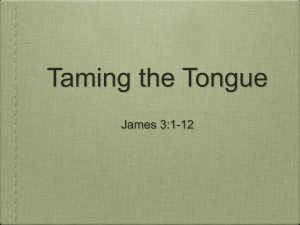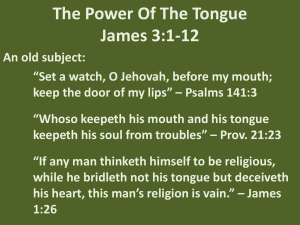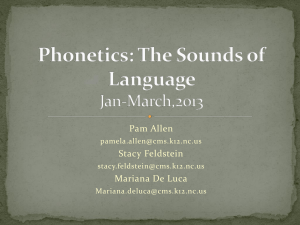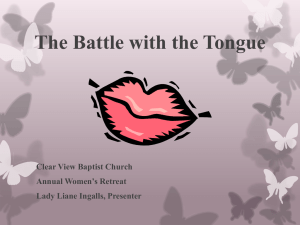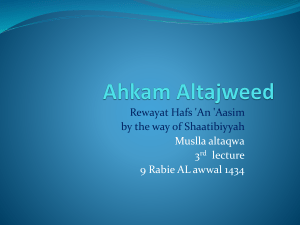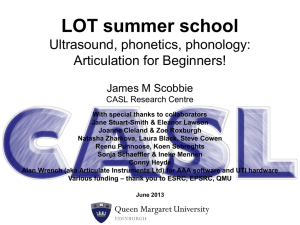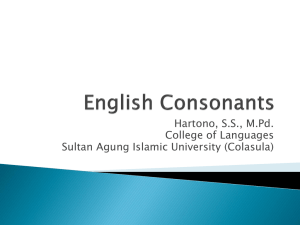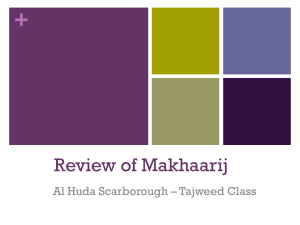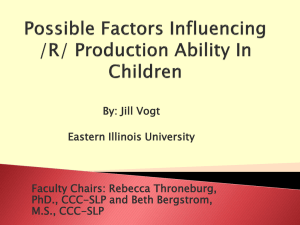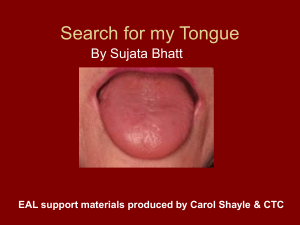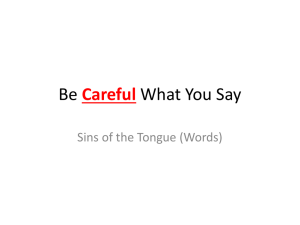Treating /r/ Distortions Using a Combined Approach of Visual
advertisement
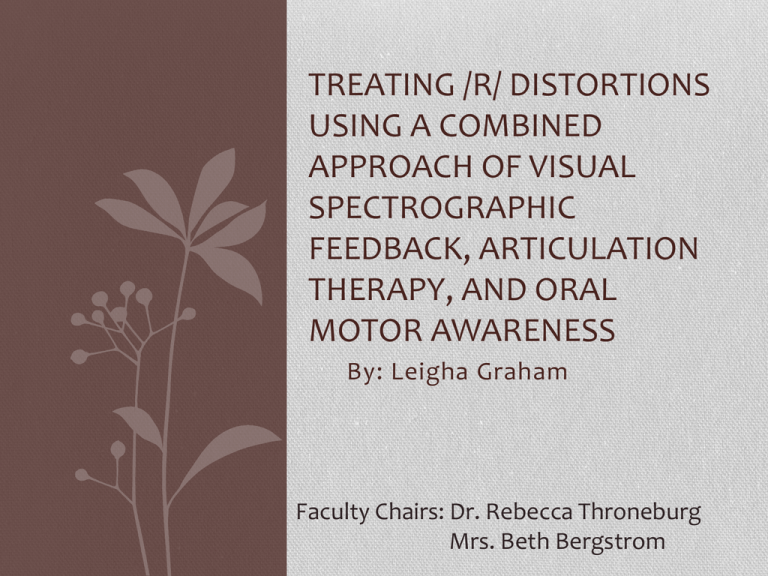
TREATING /R/ DISTORTIONS USING A COMBINED APPROACH OF VISUAL SPECTROGRAPHIC FEEDBACK, ARTICULATION THERAPY, AND ORAL MOTOR AWARENESS By: Leigha Graham Faculty Chairs: Dr. Rebecca Throneburg Mrs. Beth Bergstrom Background • Why is the /r/ phoneme difficult to remediate? • Involves different parts of the tongue that are not easy to see and describe • Tongue placement varies depending on the type of /r/ (e.g., consonantal or vocalic) • Coarticulation: Surrounding phonemes have an affect on how /r/ sounds and how /r/ is produced Two Ways to Produce /r/ Retroflex Bunched Traditional Therapy Approaches for /r/ • Discrimination • Facilitating Contexts • Progressive Approximation/Sound Modification • Shriberg (1975) 8-step /l/ to /r/ program • Phonetic Placement Training/Moto-kinesthetic Stimulation • Marshalla (2004, 2007) and Shriberg (1980) bite stick/stabilize jaw to assist /r/ establishment Research Studies Remediating /r/ • Several studies have attempted to provide tactile or visual feedback to assist accurate production of /r/ • Tactile - (Clark et al., 1993) demonstrated successful /r/ treatment with 18 elementary school children who received a specially made /r/-appliance (retainer-like apparatus) • Visual - (Adler-Bock et al., 2007) used ultrasound equipment to allow subjects to see their tongue shape and placement during /r/ treatment. This form of visual feedback was useful in helping the subjects attain tongue shapes that were similar to adult productions of /r/ • Visual - (Shuster et al 1992, 1995) used a Kay Elemetrics Model 5500 real-time spectrograph to treat /r/ distortions in one college-age student and two elementary school children. Also used spectrograph with Shriberg’s /l/ to /r/ technique. Purpose of the Current Study • The purpose of the current study was to build upon the two spectrograph studies remediating /r/ that were conducted by Shuster (1992, 1995). • The current study used free computer software rather than Kay Elemetrics equipment that was used by Shuster (1992, 1995). • The spectrograph was the primary treatment teqnique, but oral motor awareness activities and traditional articulation approaches were implemented as needed to elicit and stabilize /r/ productions. Subjects Formal and Informal Assessments Results Age PPVT- 4 Standard Score GFTA Sounds in Error G 10 108 r sz Poor tongue jaw isolation; extraneous jaw movement Poor ability to spread/flatten the tongue N 12 121 rsl Lack tongue-jaw isolation; extraneous jaw movement Very stimulable for oral motor movements C 11 111 r Lack tongue-jaw isolation; Extraneous jaw movement Difficulty with tongue height and tension r Lack tongue-jaw isolation; Extraneous jaw movement Reduced ability to spread/flatten tongue but stimulable r, sh, th Poor isolation tongue-jaw; Extraneous jaw movement Difficulty with tongue height and tension R 10 J 7 95 106 Oral-Peripheral Examination Methods - 3 Part Intervention • Approximately 10-14 hours of treatment in 5-7 weeks • 1) Spectrgraph – RTGRAM Training • 2) Phonetic Placement Training and Shaping • 3) Oral-Motor Awareness Training Spectrograph – RTGRAM Training • Speech, Hearing, and Phonetics Sciences University College London Division of Psychology and Language Sciences website at http://www.phon.ucl.ac.uk/resourc/sfs/rtgram/ • RTGRAM Settings • Sampling Rate: 16,000 samples per second • Analysis Bandwidth: Wideband (300) Hz • Time per pixel: 10 milliseconds (ms) • Dynamic Range: 70 decibels (dB) • Color Map: Grayscale RTGRAM Procedures • The SLP modeled three correct productions of /er/ • The lines and darkness of the productions were pointed out. • SLP modeled a correct /er/ and incorrect /er/ next to each other to compare the differences in lines • Subjects were asked to make their best /er/ productions and to compare it to the SLP’s production of /er/. • Were the lines in the same position? • Were the lines dark like the SLP’s lines? • Subjects were asked to move different parts of the tongue, lips, and jaw to make the image look like a correct /er/ image. Good Versus “Weak” /er/ Spectrogram of GOOD /er/ Spectrogram of “Weak” /er/ Phonetic Placement Training and Shaping • Phonetic Placement Training • Verbal description of tongue placement • Use of mirror • Tongue depressor/dental floss holder to facilitate raising of the back of the tongue • Shriberg’s (1975) 8-Step /l/ to /er/ shaping technique was used Oral-Motor Awareness Training • Isolate the jaw fro tongue movement • Placing the hand on the jaw to stabilize extraneous movement • Biting on tongue depressors while moving the tongue tip up and down • Tongue movement awareness • Placing the finger on the tip of the tongue to facilitate back placement of the tongue • Placing a candy mint on the middle of the tongue and pushing the tongue up to the roof of the mouth Progress Measures • The Entire World of R Advanced Screening • Pre and post intervention measure • Secord Contextual Articulation Test (S-CAT) Storytelling Probe of Articulation Competence • Probe measure administered each week containing two stories with vocalic /r/ and consonantal /r/ Results Results Vocalic /r/ Accuracy in Connected Speech From Weekly SCAT Probes 100 80 G N C R J 60 40 20 0 Week Week Week Week Week Week Week 1 2 3 4 5 6 7 Results Consonantal /r/ Accuracy in Connected Speech G N C R Week 2 Week 3 Week 4 Week 5 J 100 90 80 70 60 50 40 30 20 10 0 Week 1 Week 6 Week 7 Discussion • Impressions • The spectrograph was very helpful for visual feedback when children had the oral motor skills to produce /r/ (may have helped overcome faulty auditory image of correct /r/). • However for those participants without pre-requisite oral motor skills (e.g., tongue-jaw disassociation, tongue placement, and tension) the spectrograph alone was not sufficient for improving /r/ productions. Specific oral motor activities to improve awareness and position were necessary to facilitate change Discussion • Participants G, C, and J had lower levels of initial /r/ accuracy as well as lower percent accuracies from week to week. • Might have been due to more specific oral motor difficulties such as the inability to raise the tongue high in the back of the mouth • We found that the more specific and in-depth oral-motor assessment revealed each participant’s specific /r/ difficulties, which helped plan the /r/ intervention. QUESTIONS??? References Adler-Bock, M., Bernhardt, B. M., Gick, B., & Bacsfalvi, P. (2007). The use of ultrasound in remediation of North American English /r/ in 2 adolescents. American Journal of Speech-Language Pathology, 16, 128-139. doi: 10.1044/1058-0360(2007/017) Clark, C. E., Schwarz, I. E., & Blakely, R. W. (1993). The removable R -appliance as a practice device to facilitate correct production of /r/. American Journal of Speech-Language Pathology, 2(1), 84-91. Dunn, L., & Dunn, D. (2007). Peabody Picture Vocabulary Test, Fourth Edition (PPVT-4). Pearson. Goldman, R., & Fristoe, M. (2000). Goldman-Fristoe Test of Articulation, Second Edition (G-FTA-2). Pearson. Marshalla, P. (2004). Successful R therapy. Kirkland, WA: Pam Marshalla. Marshalla, P. (2007). Oral motor techniques in articulation and phonological therapy. Marshalla Speech and Language. Marshalla, P. (2008). Marshalla Oral-Sensorimotor Test (MOST). Super Duper Publications, Inc. Secord, A, & Shine, R. (1997). Secord Contextual Articulation Test (S-CAT). Super Duper Publications. Shriberg, L. (1975). A response evocation program for /ɚ/. Journal of Speech an d Hearing Disorders, 40, 92-105. Shriberg, L. (1980). An intervention procedure for children with persistent /r/ errors. Language, Speech, and Hearing Services in Schools, 11, 102-110. Shuster, L. I., Ruscello, D. M., & Smith, K. D. (1992). Evoking /r/ using visual feedback. American Journal of SpeechLanguage Pathology, 1, 29-34. Shuster, L. I., Ruscello, D. M., & Toth, A. R. (1995). The use of visual feedback to elicit correct /r/. American Journal of Speech-Language Pathology, 4(2), 37-44.
